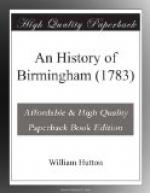We have taken a view of Birmingham in several periods of existence, during the long course of perhaps three thousand years. Standing sometimes upon presumptive ground. If the prospect has been a little clouded, it only caused us to be more attentive, that we might not be deceived. But, though we have attended her through so immense a space, we have only seen her in infancy. Comparatively small in her size, homely in her person, and coarse in her dress. Her ornaments, wholly of iron, from her own forge.
But now, her growths will be amazing; her expansion rapid, perhaps not to be paralleled in history. We shall see her rise in all the beauty of youth, of grace, of elegance, and attract the notice of the commercial world. She will also add to her iron ornaments, the lustre of every metal, that the whole earth can produce, with all their illustrious race of compounds, heightened by fancy, and garnished with jewels. She will draw from the fossil, and the vegetable kingdoms; press the ocean for shell, skin and coral. She will also tax the animal, for horn, bone, and ivory, and she will decorate the whole with the touches of her pencil.
I have met with some remarks, published in 1743, wherein the author observes, “That Birmingham, at the restoration, probably consisted only of three streets.” But it is more probable it consisted of fifteen, though not all finished, and about nine hundred houses.
I am sensible, when an author strings a parcel of streets together, he furnishes but a dry entertainment for his reader, especially to a stranger. But, as necessity demands intelligence from the historian, I must beg leave to mention the streets and their supposed number of houses.
Digbeth, nearly the same as now, except the twenty-tree houses between the two Mill-lanes, which are of a modern date, about 110 Moat-lane (Court-lane) 12 Corn-market and Shambles 40 Spiceal-street 50 Dudley-street 50 Bell-street 50 Philip-street 30 St. Martin’s-lane 15 Edgbaston-street 70 Lee’s-lane 10 Park-street, extending from Digbeth nearly to the East end of Freeman-street 80 More-street, to the bottom of Castle-street, 70 Bull-street, not so high as the Minories, 50 High-street, 100 Deritend; 120 Odd houses scattered round the verge of the town 50 —— 907 The number of inhabitants, 5,472.
The same author farther observes, “That from the Restoration to the year 1700, the streets of Birmingham were increased to thirty one.” But I can make their number only twenty-eight, and many of these far from complete. Also, that the whole number of houses were 2,504, and the inhabitants 15,032. The additional streets therefore seem to have been Castle-street, Carr’s-lane, Dale-end, Stafford-street, Bull lane, Pinfold-street, Colmore-street, the Froggery, Old Meeting-street, Worcester-street, Peck-lane, New-street, (a small part,) Lower Mill-lane.




